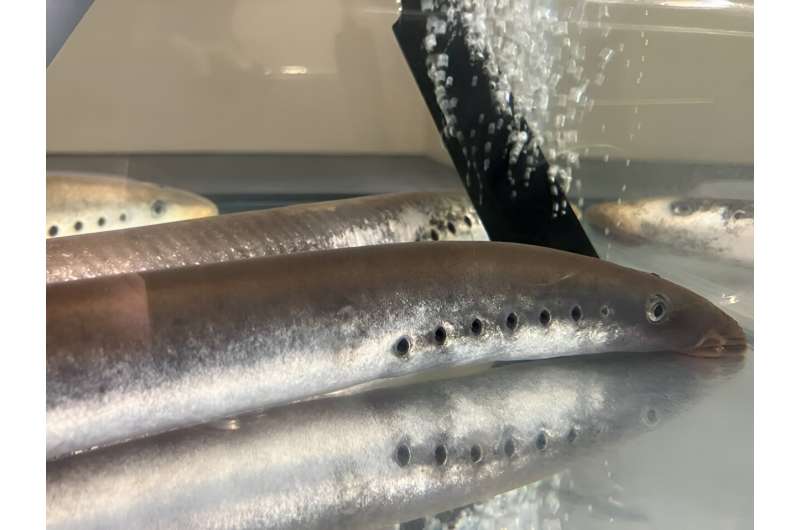This article has been reviewed according to Science X's editorial process and policies. Editors have highlighted the following attributes while ensuring the content's credibility:
fact-checked
peer-reviewed publication
proofread
Study on lamprey embryos sheds light on the evolutionary origin of vertebrate head

The origin of the vertebrate skull is a topic of much debate among evolutionary biologists. Some believe that the vertebrate head has developed as a result of modification of the segmental elements of the trunk, such as the vertebrae and somites. On the other hand, others believe that the vertebrate head has evolved as a new, unsegmented body part, unrelated to other widely observed embryonic segments somites.
Interestingly, previous studies on embryos have revealed the presence of some vestiges of somites in the head mesoderm (e.g., head cavities and somitomeres). However, homology between trunk somites and such head segments has been controversial.
The failure to understand the evolutionary origins of the vertebrate head is also attributable to the lack of studies on extant species such as lampreys, which are known to share several traits with fossil jawless vertebrates and retain primitive traits related to the head mesoderm.
While some studies have focused on the embryonic morphology of lampreys, they have often fallen short because of challenges like tissue destruction and acidic fixation during examination, making it difficult to observe the formation of head mesoderm and trunk somites.
Now, however, a research team led by Assistant Professor Takayuki Onai from the University of Fukui, Japan, has utilized advanced techniques like transmission electron microscopy and serial block-face scanning electron microscopy (SBF-SEM) to understand the development of the head mesoderm and somites in lamprey embryos.
The researchers also analyzed the morphology and gene expression patterns of cephalochordate and hemichordate (both being invertebrates) to understand the origins of somites and head mesoderm from an evolutionary perspective.
This paper is published in the journal iScience, and is co-authored by Dr. Noritaka Adachi from Aix-Marseille Université, Dr. Hidetoshi Urakubo from the National Institute for Physiological Sciences (NIPS), Dr. Fumiaki Sugahara from Hyogo Medical University, Dr. Toshihiro Aramaki from Osaka University, Dr. Mami Matsumoto from NIPS and Nagoya City University, and Dr. Nobuhiko Ohno from NIPS.
To clarify the presence or absence of somites in the head mesoderm during the early stages of diversification, the researchers focused on rosettes, which are major somite patterns and are important for the subsequent development of vertebrae. Their initial observations of lamprey embryos showed that the tissue closely related to the formation of facial muscles and other elements of the skull, known as the head mesoderm, did have cell clusters with features similar to somite rosettes.
To clarify whether these cell clusters were rosettes, they conducted ultrastructural experiments, including the SBF-SEM and gene expression analysis. The cellular morphology and gene expression examination revealed that the cell clusters were clearly distinct from rosettes. "The cell clusters we observed are likely lamprey-specific features, as they are not recognizable in the head mesoderm of both hagfish and shark embryos," explains Dr. Onai.
Furthermore, gene expression analysis also revealed the absence of segmental expression of somitogenesis-related genes, indicating their distinctiveness from somites. These findings indicate that the rosette pattern typically seen in somites is not necessarily the essential or most basic feature that defines the process of bodily segmentation.
Moreover, the experiments provide evidence that the vertebrate head mesoderm diverged during the early phases of vertebrate evolution. Furthermore, a comparison of embryos of hemichordates (a basal deuterostome), amphioxus (a basal chordate), and vertebrates revealed that the somites likely arose from the "endomesoderm" tissue of an ancient deuterostome ancestor.
The evolutionary origin of somites has been the central question in zoology for more than 150 years, and in this study, Onai et al. revealed the enigma. Regarding the evolutionary mechanism for the emergence of head mesoderm, they found that the head mesoderm emerged upon the segregation of mesodermal genes between the organisms' front and back parts (rostrocaudal axis).
"Our findings revealed a different evolutionary origin for the vertebrate head mesoderm, suggesting that it evolved from the repatterning of an ancient mesoderm and diversified even before the emergence of jawed vertebrates," concludes Dr. Onai.
In summary, the finding that the cell clusters present in the head mesoderm are distinct morphologically and molecularly from somites favors a new model where the vertebrate head mesoderm diverged during early evolution. This sheds more light on the age-old debate on the evolution of the vertebrate head and can help us advance the understanding of our own origins.
More information: Takayuki Onai et al, Ultrastructure of the lamprey head mesoderm reveals evolution of the vertebrate head, iScience (2023). DOI: 10.1016/j.isci.2023.108338
Journal information: iScience
Provided by University of Fukui





















